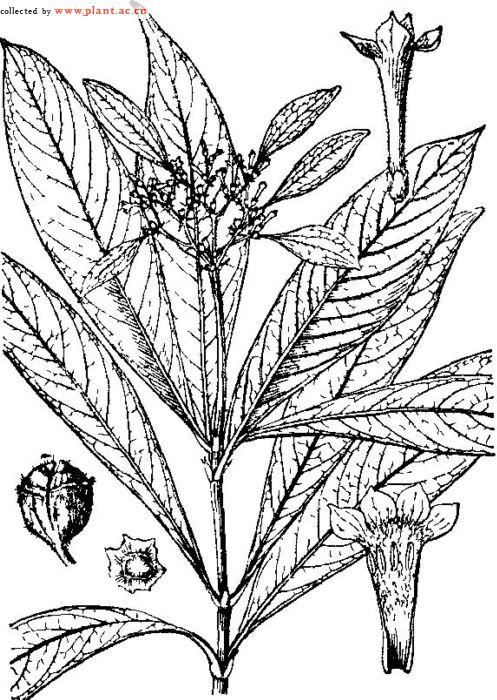绣球茜草Dunnia sinensis Tutch.
绣球茜草Dunnia sinensis Tutch.
1. 绣球茜草(中国高等植物图鉴)假黄杨(广东台山)图版58
Dunnia sinensis Tutch. in Journ. Linn. Soc. Bot. 37: 70. 1905; Pascher in Fedde, Repert. Sp. Nov. 2: 112. 1906; Chun in Sunyatsenia 4 (3-4): 260, Pl. 43. fig. 45. 1940; Li in Journ. Arn. Arb. 25: 427. 1944; How in Sunyatsenia 7 (1-2): 26. 1948; 中国高等植物图鉴4: 199, 图5811. 1975; C. E. Ridsd. in Blumea 24 (2): 367. 1978.
灌木,高0.3-2.5米;节间较短,小枝常有皱纹,嫩枝有短柔毛。叶纸质或革质,披针形或倒披针形,长7-23厘米,宽1-6厘米,顶端渐尖或短尖,很少钝,基部渐狭,常下延,边缘常反卷,幼嫩时两面被疏短柔毛,脉上较密,至成长时毛渐脱落,仅在下面脉上和上面中脉上有疏短柔毛;侧脉11-30对,密,近边缘联接,在下面凸起;叶柄长0.7-2.5厘米,有柔毛;托叶卵形或三角形,宿存,有柔毛,长6-8毫米,宽8-10毫米,顶端尖,常2裂。花序有疏短柔毛,长8-12厘米,宽3-5厘米;花梗长2-3毫米;花萼长1-2毫米,有疏短柔毛,裂片短;变态的花萼裂片白色,大,卵形或椭圆形,长2-5.5厘米,宽1-2.3厘米,具3纵脉和网脉,柄长达1.5厘米;花冠黄色,长约1.2厘米,外面疏被短柔毛,内面有长柔毛,裂片三角状卵形,长约2毫米,宽约1.5毫米;花药长1.5-2毫米,花丝长约1毫米;花柱长5-6毫米,柱头2裂。蒴果近球形,直径3-4毫米,室间开裂为2果爿,果爿顶端2裂;种子多数,扁,直径0.6-1毫米,周围有膜质的阔翅。花、果期4-11月。
产于广东龙门、新会、台山、珠海、阳春和阳江;生于海拔290-850米处的山谷溪边灌丛中或林中。模式标本采自广东台山。
《Flora of China》 Vol. 19 (2011)
Dunnia sinensis Tutcher J. Linn. Soc., Bot. 37: 70. 1905.
绣球茜草 xiu qiu qian cao
Shrubs, 0.3-2.5 m tall; branches rather stout, subterete to angled, puberulent to pilosulous sometimes becoming glabrescent with age. Petiole 0.7-2.5 cm, pilosulous or puberulent; leaf blade drying papery to leathery, narrowly lanceolate, narrowly elliptic, or oblanceolate, 7-23 × 1-6 cm, both surfaces puberulent to strigillose with pubescence denser on principal veins, sometimes becoming glabrescent with age, abaxially epidermis often with apparently enlarged cells, base acute to cuneate, margins often thinly revolute, apex acuminate, acute, or rarely obtuse; secondary veins 11-17 pairs, extending to very close to margins, with intersecondary veins often very well developed; stipules ovate or triangular, 6-8 × 8-10 mm, strigillose to puberulent, acute or often bifid for up to 1/3. Inflorescences 8-12 × 3-5 cm, moderately to densely strigillose or pilosulous; peduncle 2-6 cm; branched portion 2-4 × 3-5 cm; bracts triangular, 1-1.5 mm, petaloid bracts similar to calycophylls; pedicels to 3 mm. Calyx sparsely to densely puberulent or strigillose; ovary portion obconic, 1-1.5 mm; limb deeply lobed; lobes deltoid, 0.3-0.5 mm; petaloid calycophyll white to cream, elliptic-oblong to lanceolate, 2-5.5 × 1-2.3 cm, puberulent to glabrescent, obtuse to rounded, with 3 longitudinal veins and well-developed reticulate venation, with stipe 0.8-1.5 cm. Corolla outside sparsely to densely pilosulous or puberulent; tube 8-10 mm; lobes triangular-ovate, ca. 2 mm, acute to obtuse. Capsule 3-5 mm in diam. including beak ca. 1 mm, smooth, pilosulous to glabrescent; seeds 0.6-1 mm in diam. Fl. and fr. Apr-Nov.
● Thickets or forests in ravines; 200-900 m. Guangdong.
In conservation status, this species has been considered seriously threatened due primarily to habitat destruction (Ge et al., Conservation Genet. 3: 351-362. 2002; Chiang et al., Molec. Biol. Evol. 19: 1367-1375. 2002).In conservation status, this species has been considered seriously threatened due primarily to habitat destruction (Ge et al., Conservation Genet. 3: 351-362. 2002; Chiang et al., Molec. Biol. Evol. 19: 1367-1375. 2002).
别名:单氏木;假黄杨;绣球茜;
科名:茜草科 Rubiaceae
属名:绣球茜属 Dunnia

1. 绣球茜草(中国高等植物图鉴)假黄杨(广东台山)图版58
Dunnia sinensis Tutch. in Journ. Linn. Soc. Bot. 37: 70. 1905; Pascher in Fedde, Repert. Sp. Nov. 2: 112. 1906; Chun in Sunyatsenia 4 (3-4): 260, Pl. 43. fig. 45. 1940; Li in Journ. Arn. Arb. 25: 427. 1944; How in Sunyatsenia 7 (1-2): 26. 1948; 中国高等植物图鉴4: 199, 图5811. 1975; C. E. Ridsd. in Blumea 24 (2): 367. 1978.
灌木,高0.3-2.5米;节间较短,小枝常有皱纹,嫩枝有短柔毛。叶纸质或革质,披针形或倒披针形,长7-23厘米,宽1-6厘米,顶端渐尖或短尖,很少钝,基部渐狭,常下延,边缘常反卷,幼嫩时两面被疏短柔毛,脉上较密,至成长时毛渐脱落,仅在下面脉上和上面中脉上有疏短柔毛;侧脉11-30对,密,近边缘联接,在下面凸起;叶柄长0.7-2.5厘米,有柔毛;托叶卵形或三角形,宿存,有柔毛,长6-8毫米,宽8-10毫米,顶端尖,常2裂。花序有疏短柔毛,长8-12厘米,宽3-5厘米;花梗长2-3毫米;花萼长1-2毫米,有疏短柔毛,裂片短;变态的花萼裂片白色,大,卵形或椭圆形,长2-5.5厘米,宽1-2.3厘米,具3纵脉和网脉,柄长达1.5厘米;花冠黄色,长约1.2厘米,外面疏被短柔毛,内面有长柔毛,裂片三角状卵形,长约2毫米,宽约1.5毫米;花药长1.5-2毫米,花丝长约1毫米;花柱长5-6毫米,柱头2裂。蒴果近球形,直径3-4毫米,室间开裂为2果爿,果爿顶端2裂;种子多数,扁,直径0.6-1毫米,周围有膜质的阔翅。花、果期4-11月。
产于广东龙门、新会、台山、珠海、阳春和阳江;生于海拔290-850米处的山谷溪边灌丛中或林中。模式标本采自广东台山。
《Flora of China》 Vol. 19 (2011)
Dunnia sinensis Tutcher J. Linn. Soc., Bot. 37: 70. 1905.
绣球茜草 xiu qiu qian cao
Shrubs, 0.3-2.5 m tall; branches rather stout, subterete to angled, puberulent to pilosulous sometimes becoming glabrescent with age. Petiole 0.7-2.5 cm, pilosulous or puberulent; leaf blade drying papery to leathery, narrowly lanceolate, narrowly elliptic, or oblanceolate, 7-23 × 1-6 cm, both surfaces puberulent to strigillose with pubescence denser on principal veins, sometimes becoming glabrescent with age, abaxially epidermis often with apparently enlarged cells, base acute to cuneate, margins often thinly revolute, apex acuminate, acute, or rarely obtuse; secondary veins 11-17 pairs, extending to very close to margins, with intersecondary veins often very well developed; stipules ovate or triangular, 6-8 × 8-10 mm, strigillose to puberulent, acute or often bifid for up to 1/3. Inflorescences 8-12 × 3-5 cm, moderately to densely strigillose or pilosulous; peduncle 2-6 cm; branched portion 2-4 × 3-5 cm; bracts triangular, 1-1.5 mm, petaloid bracts similar to calycophylls; pedicels to 3 mm. Calyx sparsely to densely puberulent or strigillose; ovary portion obconic, 1-1.5 mm; limb deeply lobed; lobes deltoid, 0.3-0.5 mm; petaloid calycophyll white to cream, elliptic-oblong to lanceolate, 2-5.5 × 1-2.3 cm, puberulent to glabrescent, obtuse to rounded, with 3 longitudinal veins and well-developed reticulate venation, with stipe 0.8-1.5 cm. Corolla outside sparsely to densely pilosulous or puberulent; tube 8-10 mm; lobes triangular-ovate, ca. 2 mm, acute to obtuse. Capsule 3-5 mm in diam. including beak ca. 1 mm, smooth, pilosulous to glabrescent; seeds 0.6-1 mm in diam. Fl. and fr. Apr-Nov.
● Thickets or forests in ravines; 200-900 m. Guangdong.
In conservation status, this species has been considered seriously threatened due primarily to habitat destruction (Ge et al., Conservation Genet. 3: 351-362. 2002; Chiang et al., Molec. Biol. Evol. 19: 1367-1375. 2002).In conservation status, this species has been considered seriously threatened due primarily to habitat destruction (Ge et al., Conservation Genet. 3: 351-362. 2002; Chiang et al., Molec. Biol. Evol. 19: 1367-1375. 2002).

